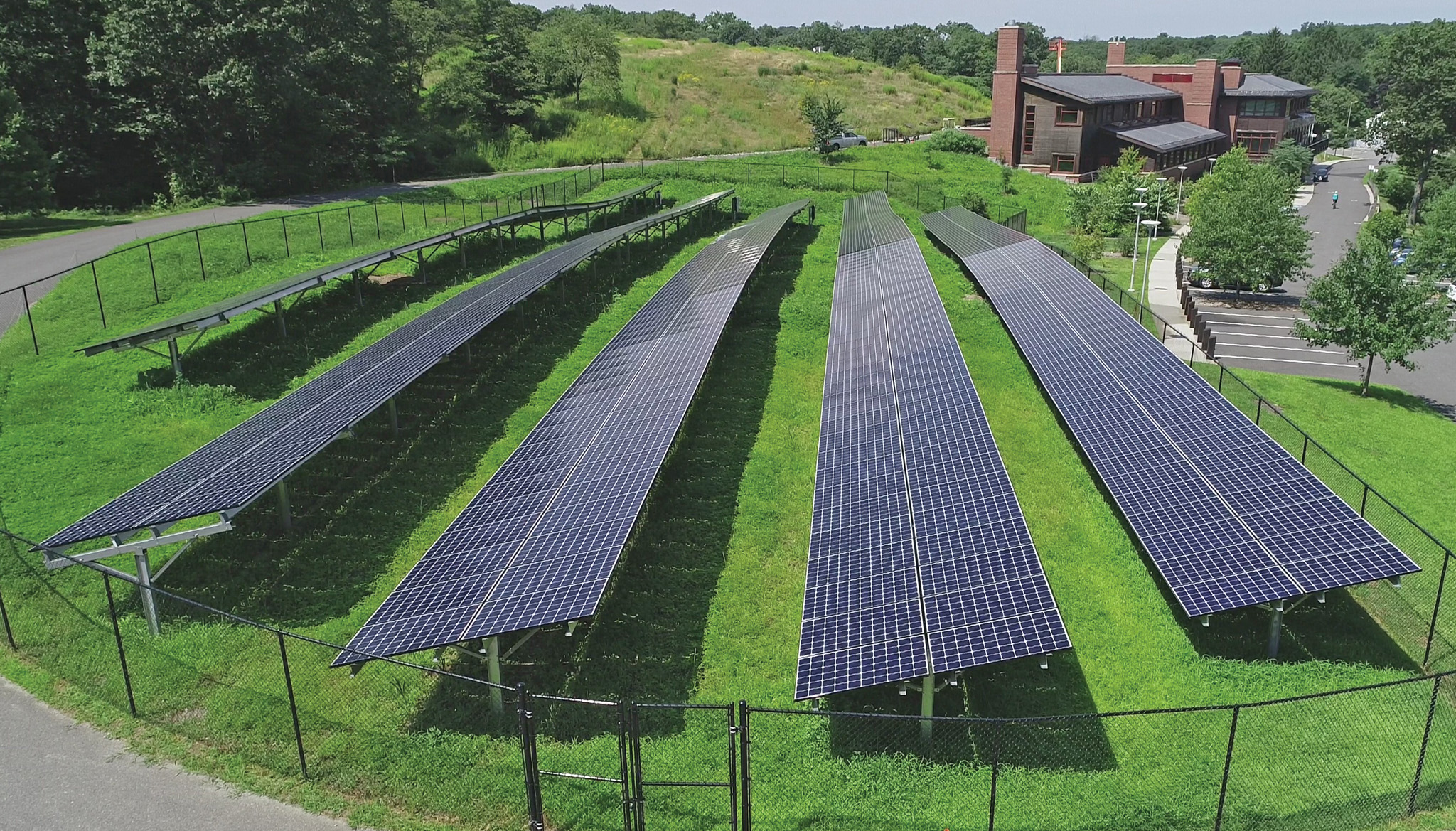
The living collections of the Arnold Arboretum have thrived for nearly 150 years by using the sun’s rays to turn carbon dioxide and water into energy. Now, through a groundbreaking new project, the Arboretum will rely on solar power to fuel its advanced scientific research facilities, furthering both its commitment to renewable energy and its dedication to the study of plant life on Earth.
Situated on 1.2 acres in the Roslindale portion of the Arboretum, the project combines solar collection and the storage capabilities of a unique battery array to reduce the consumption of fossil fuels for operating the Weld Hill Research and Education Building. On any given day you will find faculty, researchers, and students from Harvard University and around the world utilizing the building’s state-of-the-art laboratories, greenhouses, growth chambers, and classrooms—all relying on a steady and dependable flow of electricity. The Arboretum will draw up to 30 percent of its energy needs for Weld Hill via 1,152 ground-mounted solar panels and a 145-panel solar awning once the project is completed this fall.While certainly the Weld Hill Solar Project marks the institution’s most ambitious sustainability initiative to date, it’s not the first of its kind at the Arnold Arboretum. In 2016, the Arboretum installed its first solar panel array on the roof of the Hunnewell Building maintenance garage. A second array was installed in 2017 atop the headhouse of the Dana Greenhouses. Additional sustainability projects in recent years have included everything from retrofitting buildings with efficient LED fixtures to installing charging stations for electric cars in its staff parking lots.
Arboretum Director William (Ned) Friedman has made it a priority since his arrival in 2011 to decrease the institution’s reliance on fossil fuels, and these projects demonstrate that climate change solutions can begin in our own backyards. “The planet’s biodiversity has been harnessing the sun’s energy forever,” he said. “It is time humans put solar energy generation and storage technology to work to do more. It’s a moral mandate—at the Arboretum we are taking responsibility for our carbon footprint and our continuing and collective obligations to the planet.”
The Weld Hill Solar Project employs the latest and most innovative solar technology available. Photovoltaic (PV) arrays convert light directly into electricity and are capable of producing more than 542,061 kilowatt hours annually. The panels work in conjunction with a sophisticated battery storage system that mitigates usage during high-demand periods and uses stored energy to reduce peak draw from the power grid. Over the next 25 years, the Arboretum’s three solar projects could potentially offset an equivalent of some 1,144 metric tons of carbon dioxide, comparable to burning 1,250,650 pounds of coal, consuming 2,649 barrels of oil, or charging 145,874,092 smartphones.
Ensuring a reliable and economical supply of power over the long term in an urban environment makes sense to the goals and values of the Arboretum, and its solar projects and suite of sustainability initiatives align with like-minded community programs including the City of Boston’s “Carbon Free Boston” and the Massachusetts SMART (Solar Massachusetts Renewable Target) program. It also complements Harvard’s “Climate Action Plan” to operate free of fossil-fuels by 2050. The Arboretum partnered with the University’s Green Revolving Fund to fund its solar projects through interest-free loans.
But the benefits of solar power at the Arboretum extend beyond harvesting the sun for renewable energy. The Weld Hill project also includes considerations of the environmental sustainability of its site and the health of local ecosystems. Another example of how the institution thinks comprehensively about landscape health and environmental stewardship, the project was designed to maximize space beneath the east array for the establishment of a pollinator meadow. This managed ecosystem of sustainably-collected native plants will be the first of its kind for a solar field in Massachusetts, providing urban habitat for a variety of native pollinators, birds, and other wildlife.
For the Arboretum, working to mitigate climate change and its effects through endeavors like these will continue to shape the institution and its priorities. Director Friedman said concern for the human-caused environmental degradation of the natural world shapes every action at the Arboretum—from caring for the more than 16,000 accessioned plants in the Living Collections to ensuring that we minimize our impact on the world’s biodiversity.“We have a responsibility to nature,” he continued. “In so many ways, it’s magic what a plant can do. Every leaf is a solar panel—it couldn’t be simpler and yet so magnificent and breathtaking,” he said. “This project is such a natural fit for the Arboretum and for Harvard. We need to make a positive difference each and every day.”
From “free” to “friend”…
Established in 1911 as the Bulletin of Popular Information, Arnoldia has long been a definitive forum for conversations about temperate woody plants and their landscapes. In 2022, we rolled out a new vision for the magazine as a vigorous forum for tales of plant exploration, behind-the-scenes glimpses of botanical research, and deep dives into the history of gardens, landscapes, and science. The new Arnoldia includes poetry, visual art, and literary essays, following the human imagination wherever it entangles with trees.
It takes resources to gather and nurture these new voices, and we depend on the support of our member-subscribers to make it possible. But membership means more: by becoming a member of the Arnold Arboretum, you help to keep our collection vibrant and our research and educational mission active. Through the pages of Arnoldia, you can take part in the life of this free-to-all landscape whether you live next door or an ocean away.

